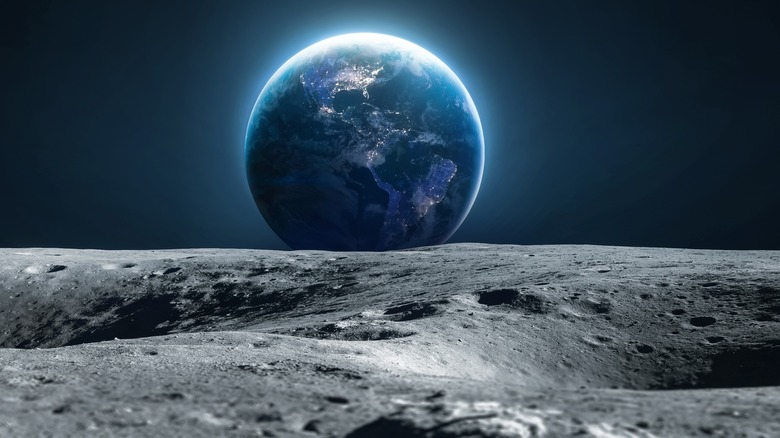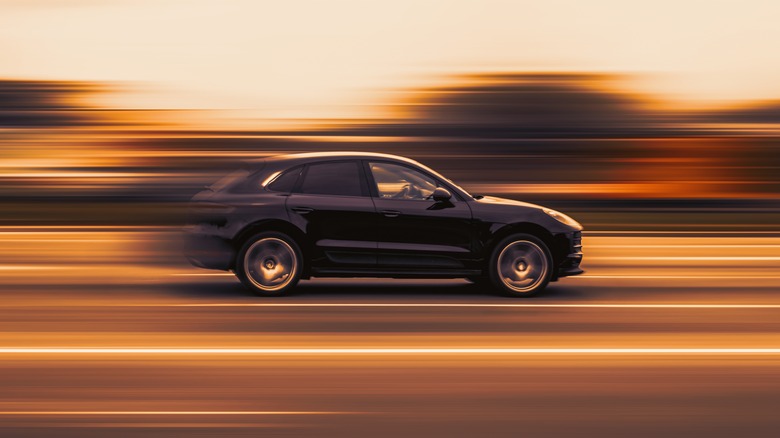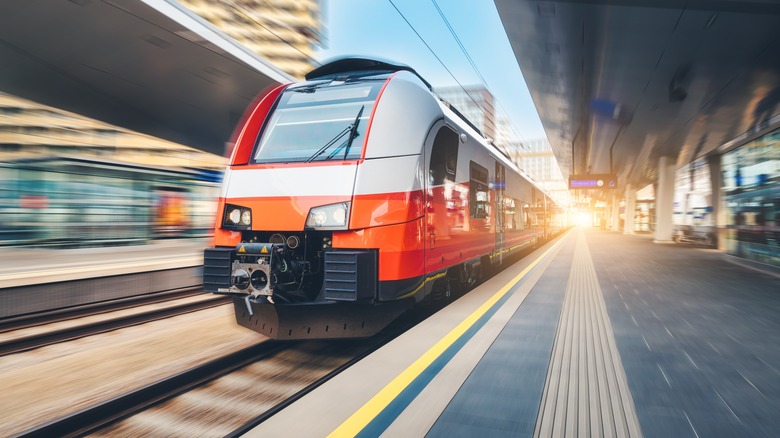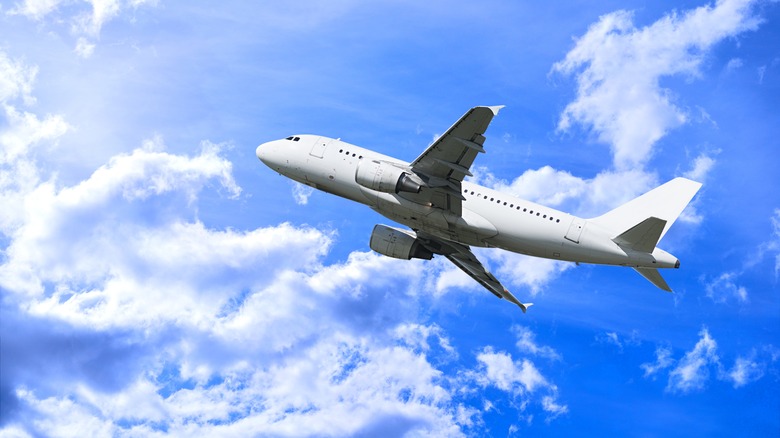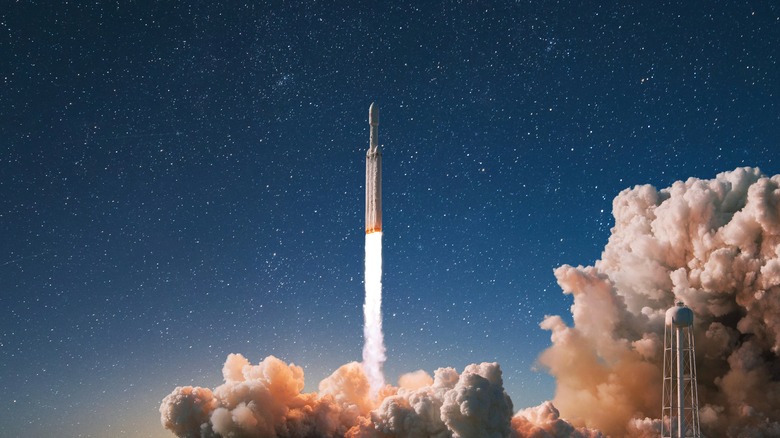How Long Would It Take To Get To The Moon With Different Transportation Methods?
If you're like many people and have wondered why humans haven't gone back to the moon since 1972, there are several explanations to this, with most of them involving money. It has indeed been more than 50 years since humans traveled to the moon, which occurred during the 1972 Apollo 17 mission. While the U.S. landed a robot on the moon in 2024, it didn't include any human occupants, and NASA is working on possibly bringing a human crew to the moon in 2026. In the meantime, it's fun thinking about how common transportation methods on Earth could stack up to ongoing technological advancements in space travel.
Not only are there different moon phases to consider, but the way the moon orbits the earth makes such hypothetical transportation scenarios not so clear cut. Depending on Earth's rotation and the moon's orbit, there's anywhere between 363,104 kilometers (225,622 miles) and 405,696 kilometers (252,088 miles) of distance between the moon and our planet. As such, Apollo 17 took more than 86 hours to reach the moon in 1972, while the Apollo 11 moon landing occurred after nearly 76 hours. There's not a definitive way to determine the exact amount of time it would take to reach the moon from Earth (it's not a straight-line journey), but there are estimates based on different transportation methods to give perspective on just how long this journey could take. The average distance is about 238,855 miles, which is the math we will use to calculate these hypothetical scenarios.
Traveling to the moon by car could take several months
Once automobiles became more mainstream, many Americans have since reveled in taking road trips. Due to the ubiquity of automobiles, this is a common mode of transportation people might hypothesize as a way to explore space one day. You might even wonder if you could fly to the moon in a car. As it stands right now, however, it would take several months for the average car to reach the moon — and this doesn't include stopping for fuel, food, or stretching your legs.
There are several factors that make a car fast, including the type of engine and amount of horsepower it has. The size and weight of the vehicle also matters. Collectively, these are all reasons why a sports car is capable of going much faster than a family sedan. For the purposes of hypothesizing lunar travel, though, you can try to measure this at a speed of 60 mph. If you drove this fast along the average distance between the moon and Earth, it could take almost six months. Even if you kicked the speed up to 65 mph, you would still be facing a potential 150-plus days' worth of driving.
Trains could possibly pave the way for more future lunar tourism
There are certainly pros and cons of returning to the moon to consider, with time and expenses being important drawbacks for government investments. To that end, there are some interesting concepts private companies have developed outside of government agencies when trying to figure out how to get people to the moon. While you might be more familiar with rockets, there's even some exploration involving train travel. One example is the Space Railway, which is currently developing possible solutions to space via a tethering system.
Still, the big question is how long such a space train might take to travel to the moon. Trains on Earth are becoming faster than ever, and it's possible that some of this technology might be applied to space travel. Earth's fastest train (currently) is the Shanghai Maglev, which travels 286 mph. In theory, a train of this speed could reach the moon in just over a month. If the technology continues to trend this way, it's possible for space tourism via train to eventually make stops on the moon in a short amount of time.
Planes may be a possible lunar transportation mode
Aside from automobiles and trains, planes have undergone significant evolutionary changes in the last century. The first commercial plane was technically an airboat, and it started offering flights on January 1, 1914. The company boasted being able to travel 18 miles between Tampa and St. Petersburg, Florida, in just 23 minutes. It could only take one passenger at a time, and the service only ran for about four months. Nevertheless, the St. Petersburg-Tampa Airboat Line paved the way for commercial aircraft, and some people have even wondered whether it could be possible to fly one to the moon at some point.
A commercial aircraft has even the fastest train beat in terms of speed, with an average of 545 to 575 mph. If you were aboard a plane on the lower end of this range at 545 mph, you might be able to reach the moon in just under three weeks. Still, passenger flights are not among NASA's goals, and it's not what the organization actually does. Instead, these flights would likely be private commercial air carriers that could possibly transport multiple people at once on lunar visits. This might sound far-fetched, but early commercial airliners were thinking about this possibility as far back as the 1960s. During the latter part of the decade, the now-bankrupt Pan Am Airways launched a "First Moon Flights" club, which promised members transportation to the moon with a target launch date of 2000.
Bicycling is a slower method with some gravitational pulls to consider
Riding a bike is a fun experience for many, though there are always some obstacles you'll encounter during your ride. There are two major obstacles if you were to apply this mode of transportation to a lunar journey. For one, the sheer distance would take several hundred days. In fact, if you were to ride a bike to the moon at a reasonable pace of 12 mph along the average distance between Earth and the moon, it could take you more than 2 years to reach the moon.
Of course, this estimate is measured by a straight line of distance only and based on the related math. To that end, there is a second obstacle a bike rider might encounter on their way to the moon: gravitational changes. It might seem that this would make the journey more cumbersome, but some experts have estimated that these gravitational changes could actually help propel you forward. With this in mind, one physicist estimated on Wired that a bike could conceivably travel at 37 mph and arrive to the moon after 267 days.
Walking to the moon would take several years
Walking is, of course, the slowest mode of transportation, and it's often interesting to see how much time you save bicycling or driving to some of the places you frequent. Not surprisingly, walking to the moon would indeed take much longer than other modes of transportation. Just how long is variable, but the estimated timeframe is nonetheless hard to fathom.
Keeping the average distance between the earth and the moon in mind, BBC's Sky at Night Magazine estimates that it could take 2,669 days to reach the moon by walking at a brisk 3.7 mph. This is more than 7 years of walking non-stop! However, this timeline would arguably much slower, as the average walking pace can vary. In fact, the Centers for Disease Control and Prevention estimates 2.5 mph as a moderate pace for the average adult. Given this fact, it could take most people much longer than 7 years to walk to the moon.
Modern spacecraft could possibly evolve to help transport humans to the moon much quicker
As modern spacecraft continuously evolve, it's worth wondering whether future rockets could possibly transport humans to the moon quicker. Conceivably, these transportation methods could become even faster as rocket technology improves. Yet, faster rockets cannot work around the other obstacles that lie between the moon and Earth, keeping in mind that this is not a straight-line destination. To date, Apollo 8 holds the record for the quickest crewed rocket launch to the moon with human occupants at just over 69 hours. Notably, this mission occurred at the end of 1968, which was several months before Apollo 11 landed on the moon on July 20, 1969. Apollo 8 did not land on the surface of the moon.
Overall, experts estimate that it would still take an average of three days to reach the moon with current rocket technology. While there are currently rockets available that can go at high speeds and possibly make it to the moon from Earth in minutes, these are not crewed vessels. As more of these types of rockets are developed in the future, human transport within a reasonable timeframe isn't out of the question, especially considering the effect the first moon landing has had on the world since Apollo 11's successful mission.
